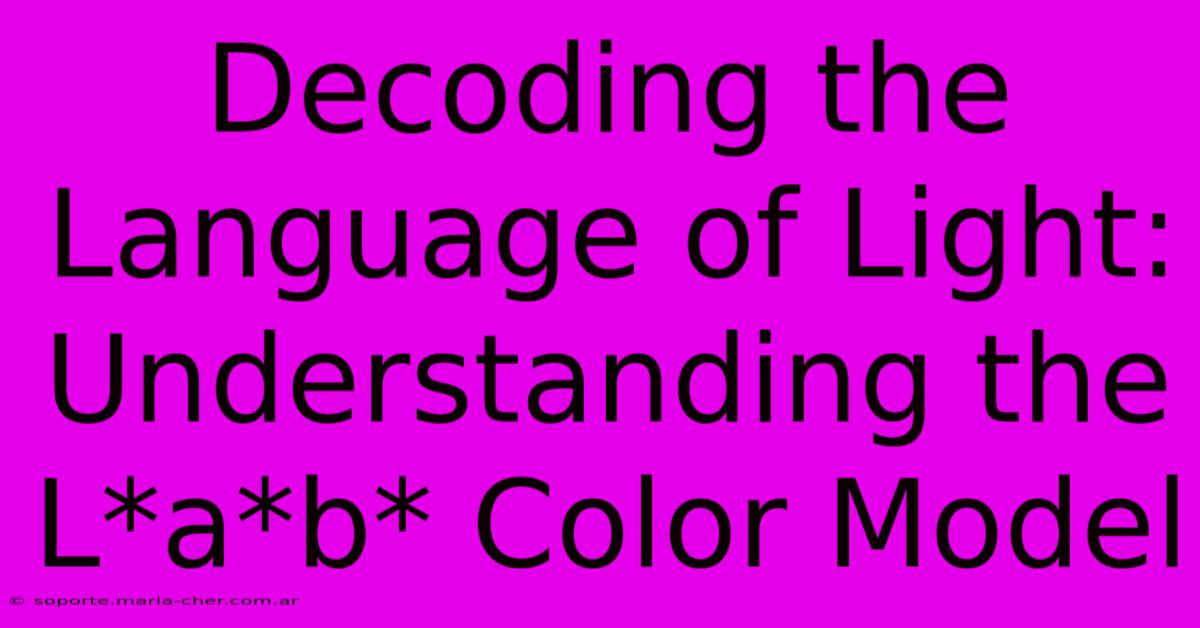Decoding The Language Of Light: Understanding The L*a*b* Color Model

Table of Contents
Decoding the Language of Light: Understanding the Lab* Color Model
Color is everywhere, influencing our emotions, perceptions, and even our purchasing decisions. But how do computers and digital devices understand and reproduce the vibrant spectrum we see? This is where the Lab* color model comes in, offering a powerful and precise way to describe and manipulate color, far beyond the limitations of simpler systems like RGB. This comprehensive guide will decode the language of light and unlock the secrets of the Lab* color space.
What is the Lab* Color Model?
The Lab* color model, also known as CIELAB, is a device-independent color space. Unlike RGB (Red, Green, Blue) which is dependent on the device displaying the color, Lab* defines color based on human perception. This means that a specific Lab* value will represent the same color regardless of the monitor, printer, or other output device used. This makes it invaluable for color management in printing, graphic design, and other applications where consistent color reproduction is crucial.
Understanding the Components:
-
L (Lightness):* This component represents the lightness or darkness of a color, ranging from 0 (black) to 100 (white). A value of 50 represents a mid-gray.
-
a (Green-Red):* This axis describes the green-red opponent colors. Negative values indicate green, while positive values indicate red.
-
b (Blue-Yellow):* This axis represents the blue-yellow opponent colors. Negative values indicate blue, and positive values indicate yellow.
Think of it as a three-dimensional space, where each color occupies a unique position defined by its L*, a*, and b* values. This allows for incredibly fine-grained control over color, capturing nuances that are often lost in simpler models.
Why Choose Lab*? The Advantages
The Lab* color model offers several key advantages over other color spaces:
-
Device Independence: Its device-independent nature ensures consistent color reproduction across different devices. This is vital for professionals who need to guarantee accurate color matching.
-
Perceptually Uniform: Lab*'s structure closely mirrors human color perception. Small changes in Lab* values correspond to similarly perceived small changes in color, unlike RGB where the same numerical change can result in vastly different perceived color shifts depending on the location in the color space.
-
Wider Gamut: Lab* can represent a wider range of colors than RGB, encompassing colors that are impossible to reproduce on typical displays. This is especially useful for simulating colors in natural environments or specialized printing processes.
-
Precise Color Calculations: The perceptual uniformity of Lab* makes it ideal for performing accurate color calculations, like determining color differences or mixing colors mathematically.
Applications of the Lab* Color Model
The versatility of the Lab* color model makes it a vital tool in various fields:
-
Graphic Design and Printing: Ensuring consistent color across various media, from screen to print.
-
Photography and Image Editing: Fine-tuning colors for optimal visual impact and correcting color casts.
-
Textile and Fashion Industries: Matching colors precisely for fabric production and garment manufacturing.
-
Food Science: Analyzing and standardizing food colors.
-
Industrial Quality Control: Maintaining color consistency in manufacturing processes.
Lab* vs. RGB: A Quick Comparison
| Feature | Lab* | RGB |
|---|---|---|
| Device Dependence | Device-independent | Device-dependent |
| Perceptual Uniformity | Perceptually uniform | Not perceptually uniform |
| Gamut | Wider | Narrower |
| Color Mixing | More accurate and predictable calculations | Less accurate and less predictable |
| Primary Use | Color management, accurate color reproduction | Displaying colors on screens |
Conclusion: Mastering the Language of Light
Understanding the Lab* color model opens up a world of possibilities for anyone working with color. Its device independence, perceptual uniformity, and wider gamut make it an indispensable tool for achieving precise and consistent color reproduction, regardless of the output device. Whether you're a graphic designer, photographer, or simply curious about the science of color, mastering Lab* is a valuable asset in the digital age. So, dive in, explore its capabilities, and start decoding the language of light!

Thank you for visiting our website wich cover about Decoding The Language Of Light: Understanding The L*a*b* Color Model. We hope the information provided has been useful to you. Feel free to contact us if you have any questions or need further assistance. See you next time and dont miss to bookmark.
Featured Posts
-
Warning This White Party Invitation May Cause Fomo
Feb 10, 2025
-
Finding Solace In Loss Seek Comfort In Honakers Obituaries
Feb 10, 2025
-
The Alchemist Of Intellect The King Of Swords Transformation
Feb 10, 2025
-
Are You Color Blind Discover The Truth With The Farnsworth Munsell Test
Feb 10, 2025
-
Meet The Powerhouse 7 Inspiring Black Graphic Designers Who Will Fuel Your Creativity
Feb 10, 2025
